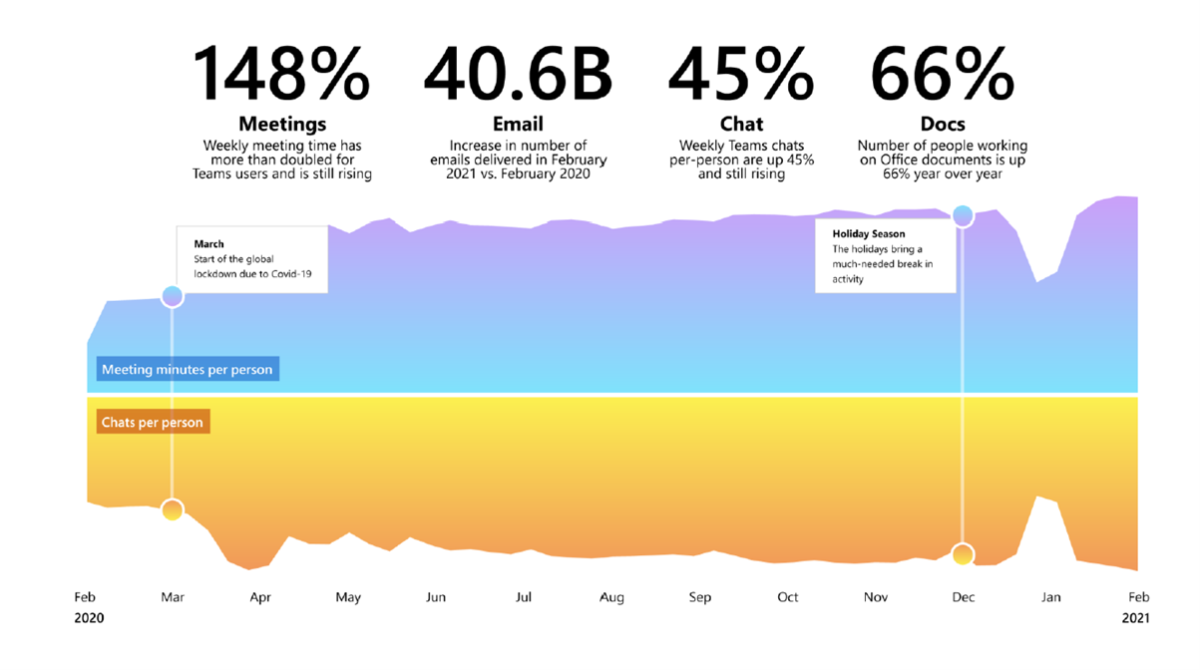Avid readers Bird’s Eye View will recall last week’s note on the schizophrenic tensions seen in audiences now that shopping and socialising opportunities have been restored to us. Despite the crowds in Soho most nights and the vaccination, it’s clear that not all of us want to return to crowded shops and bars.
As an observer (in real life) of the new rush hour – check out the tubes coming into town between 4pm and 6pm – I’d assumed that a return to the office would be delayed, and with little demand. Meeting in pubs- yes; meeting in rooms and at desks- no. But an insightful piece of research from Microsoft and Edelman has made me change my mind.
Headlines have been grabbed by the promises from tech industry leaders that we will all work from home. Bosses are promising office workers that all options will be open going forward, with the buzz word of the moment being “Hybrid” work. But these headlines are being written with the pronouncements of “leaders” and they have had a very different lockdown to others. Figure one, below shows the split between those claiming to be “thriving” and those “surviving or struggling” when asked in January 2021.
Figure One: The leaders have thrived at home; the young and single have not

Source: Work trend Index 2021
Part of the discrepancy will be down to environment, after all most leaders will have a better and larger home office. But its also about control. The biggest single shock from this report, which made me examine my own behaviour and recognise its truth, can be seen in figure two below.
Microsoft have cleverly blended datasets from their global Office 365 usage over the last year, with the survey data used for the previous chart. Their analysis of tool usage data highlights how these wonderful digital tools, which have allowed us to work from home, have come to dominate our days. We just haven’t found how to switch off, and thus are spending longer and longer on more and more tasks.
Figure two: Productivity has gone up, driven by longer meetings, more emails, and more documents

Source: Work trends Index 2021 Office 365 tool usage
50% of users are responding to a Teams chat within five minutes; we are spending more time working out of work hours- up by 42% year on year, and our meetings are on average ten minutes longer, giving us less down time to recover. The survey found 54% of respondents felt overworked and 39% felt exhausted. Once again, this impact was exacerbated amongst the young, who felt less able to cope and contribute.
The last chart I am going to share is the first quantification of a belief I have held for a while: Working from home has increased productivity for tasks that are based on previous skills and knowledge but has made creativity and solving new problems much harder. Microsoft have produced a great piece of analysis to explain why this might be. If you are in the office, you are subject to serendipity i.e., chance meetings with someone you bump into. No one “bumps into” another person on a Teams call which makes the gene pool of ideas stubbornly static.
Figure three illustrates this perfectly. Lockdown and home working has reduced the number of different contacts we make in our working week. Our circle of co-workers or even casual conversations has fallen off a cliff. We are spending more time with fewer people. Our lives are lived socially in an echo chamber within the confines of the Facebook algorithm, and career wise have been restricted to those whose ideas we know best. New learning is limited by those closed user groups.
Figure three: Lockdown has restricted the breadth of our workplace interactions

Source: Work trends Index 2021
So, what might all this mean for advertisers? All of the above is most felt by the young- the under 30’s at the start of their careers. They need to build their networks; they have grown up in a digital first world and have fewer real-life disciplines of turning devices off. They, I suspect, will return to the workplace sooner, in greater numbers, and for more days each week, than their elders.
Out Of Home and transport media are likely to show rapid recovery over the summer, not just in the new rush hour of 4pm-6pm, but also in the traditional rush hour of 7am-9am. Opportunities will arise in smart planning, to spot and create engagement opportunities for these young audiences going back to work. They will also arise in creating new products and experiences for them- much of the city centre infrastructure like small local cafes have withered in the last year. Can your brand capture thirty minutes of your audience’s time, and earn their gratitude by providing a new service?
And finally, there may well be some smart media buying opportunities for advertisers that move ahead of the crowd and bring investments to a medium starved more than any apart from cinema this last year. If city centres are going to be fuller, and throughout the day, media investment will quickly follow.
By Mike Colling, Founder of The Kite Factory
